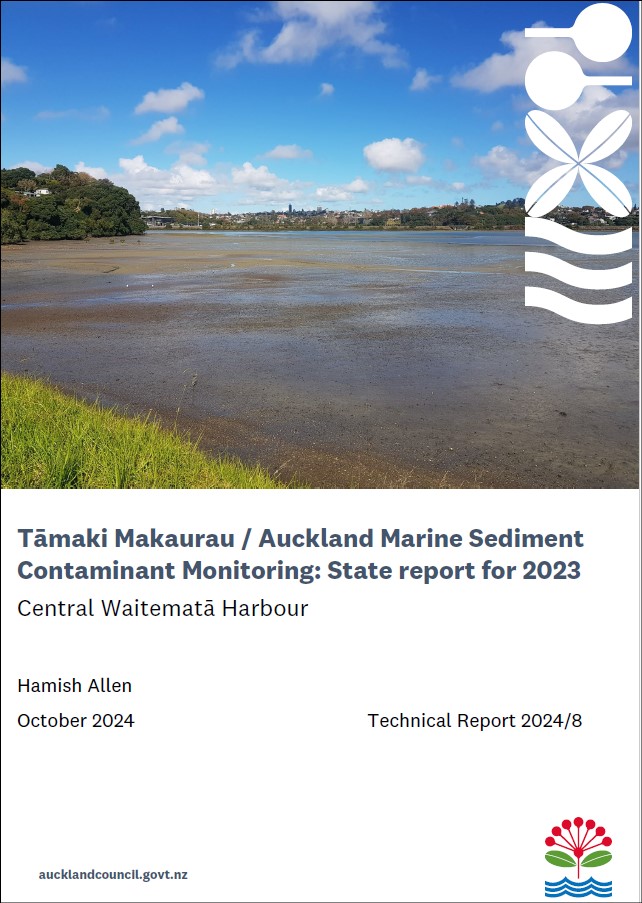Tāmaki Makaurau / Auckland marine sediment contaminant monitoring: state report for 2023
Author:
Hamish AllenSource:
Auckland Council Environmental Evaluation and Monitoring UnitPublication date:
2024Topics:
EnvironmentExecutive summary
Contaminants such as copper, lead, zinc, arsenic, and mercury can accumulate in the sediments of our harbours, estuaries, and beaches. They originate from a range of different activities and land uses including vehicle tyre and brake wear, industrial discharges, use of agrichemicals, and the breakdown of some building materials. When it rains, these pollutants can wash into our stormwater networks and waterways, ending up in our marine environment. The build-up of these contaminants can affect ecological health by reducing the abundance and/or diversity of animals living in the sediment. This results in degraded communities that are dominated by the remaining few species that are tolerant of higher contaminant levels, with flow-on effects for the natural functioning of these ecosystems. Understanding the distribution and level of chemical contaminants in marine sediments provides a useful marker of land use impacts on aquatic receiving environments and ecosystem health.
This report provides a summary of sediment contaminant (metals) state and changes over time in state, at 19 Central Waitematā Harbour sites sampled in 2023. Monitoring is carried out through Auckland Council’s Regional Sediment Contaminant Monitoring Programme (RSCMP), which regularly gathers chemical contaminant data from the region's harbours and estuaries. This document also outlines the procedures for monitoring and analysis, as well as the quality assurance assessments conducted.
Samples used for sediment chemistry analysis were processed and analysed for the following metals: copper, lead, zinc, arsenic (a metalloid species), and mercury. At three sites in the Whau Estuary, cadmium, chromium, nickel, and silver were also tested. Total recoverable metals, on the <500μm fraction, were analysed. One composite sample from each site was also analysed for particle size distribution.
The quality assurance data analysis indicated that the metals and particle size distribution data obtained in 2023 are largely within acceptance criteria and considered suitable for use in the RSCMP.
Contaminant state is compared with sediment quality guidelines (thresholds used to assess the potential impact of sediment contamination on benthic health). These include the Australian and New Zealand Guidelines for fresh and marine water quality (ANZG), and the more conservative Auckland Council Environmental Response Criteria (ERC), and Threshold Effects Level / Probable Effects Level (TEL/PEL). See section 3.1 for more detail on the sediment quality guidelines used in the RSCMP. More detailed trend analysis, which involves statistical evaluations of monitoring data to assess the magnitude and direction of change over time, is conducted every few years in separate reports. For the most recent findings see Mills and Allen (2021).
Results from sampling undertaken in 2023 showed a wide range of sediment contamination. Just over half the sites sampled triggered conservative guidelines for one or more of the contaminants analysed (10 out of 19 sites; 53%), while slightly fewer sites triggered the higher ANZG amber thresholds (9 out of 19 sites; 47%). Overall, across all metals analysed, there are far fewer exceedances of the ANZG thresholds compared with more conservative guidelines (32 exceedances of the ERC and/or the TEL/PEL, compared to 14 for the ANZG). Encouragingly, no sites sampled in 2023 triggered the ANZG red threshold for any metal.
The spatial pattern of contamination remains consistent with previous monitoring in the Central Waitematā. The more exposed and sandier sites on the northern shoreline recorded low levels of metals, while elevated concentrations were observed at several muddy and sheltered sites along the southern shoreline, in the Whau Estuary and (to a lesser degree) in Hobson Bay.
Zinc remains the metal that most regularly exceeds ERC guidelines. Zinc triggered the ERC red threshold at six sites, and the amber threshold at a further two sites. Levels of elevated zinc are most prevalent in catchments with intensive industrial and urban areas, particularly where there is a long history of this type of land use, such as the catchment surrounding the Whau Estuary and sites along the southern shoreline to the west of the city centre.
The analysis of cadmium, chromium, nickel, and silver at sites in the Whau Estuary was undertaken to gauge the impact these contaminants may be having in a highly urbanised catchment. Results showed relatively low levels of these metals, indicating that any ecological impact would be minimal according to sediment quality guidelines.
In general, ERC contaminant status (for metals copper, lead, and zinc) has remained relatively stable over time. Where changes did occur, they were a mix of relatively small fluctuations above or below guideline thresholds, and more considerable differences, as was the case for improving copper and lead levels at site Whau Wairau and conversely, worsening copper and lead levels at site Whau Upper. These sites are located relatively close to one another in the same broad catchment and the varying differences observed demonstrate the site-specific nature of sediment contaminant accumulation, and the fine-scale dynamics that can occur within an estuary.
Auckland Council technical report, TR2024/8
October 2024
See also
